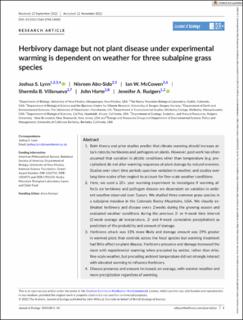| dc.description.abstract | Both theory and prior studies predict that climate warming should increase attack rates by herbivores and pathogens on plants. However, past work has often assumed that variation in abiotic conditions other than temperature (e.g. precipitation) do not alter warming responses of plant damage by natural enemies. Studies over short time periods span low variation in weather, and studies over long time-scales often neglect to account for fine-scale weather conditions.
Here, we used a 20+ year warming experiment to investigate if warming affects on herbivory and pathogen disease are dependent on variation in ambient weather observed over 3 years. We studied three common grass species in a subalpine meadow in the Colorado Rocky Mountains, USA. We visually estimated herbivory and disease every 2 weeks during the growing season and evaluated weather conditions during the previous 2- or 4-week time interval (2-week average air temperature, 2- and 4-week cumulative precipitation) as predictors of the probability and amount of damage.
Herbivore attack was 13% more likely and damage amount was 29% greater in warmed plots than controls across the focal species but warming treatment had little affect on plant disease. Herbivory presence and damage increased the most with experimental warming when preceded by wetter, rather than drier, fine-scale weather, but preceding ambient temperature did not strongly interact with elevated warming to influence herbivory.
Disease presence and amount increased, on average, with warmer weather and more precipitation regardless of warming.
Synthesis. The effect of warming over reference climate on herbivore damage is dependent on and amplified by fine-scale weather variation, suggesting more boom-and-bust damage dynamics with increasing climate variability. However, the mean effect of regional climate change is likely reduced monsoon rainfall, for which we predict a reduction in insect herbivore damage. Plant disease was generally unresponsive to warming, which may be a consequence of our coarse disease estimates that did not track specific pathogen species or guilds. The results point towards temperature as an important but not sufficient determinant and regulator of species interactions, where precipitation and other constraints may determine the affect of warming. | en_US |

